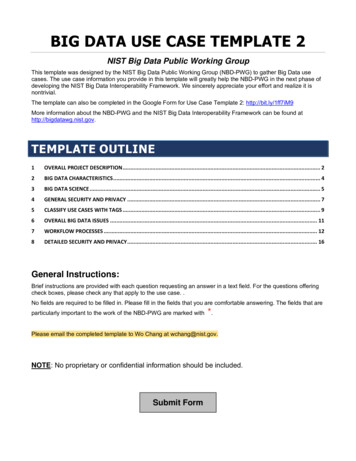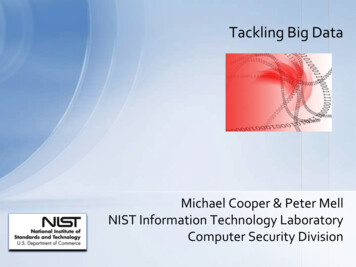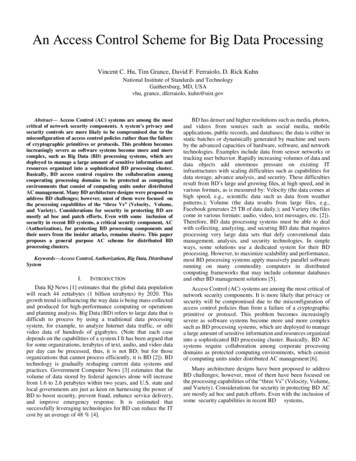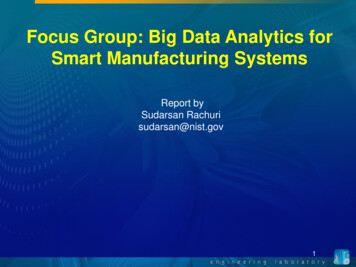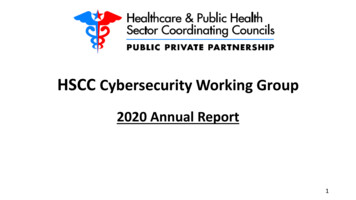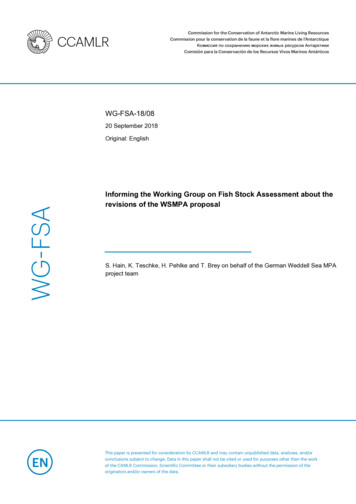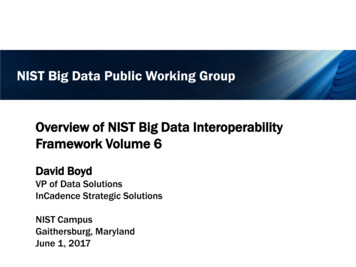
Transcription
NIST Big Data Public Working GroupOverview of NIST Big Data InteroperabilityFramework Volume 6David BoydVP of Data SolutionsInCadence Strategic SolutionsNIST CampusGaithersburg, MarylandJune 1, 2017
Presentation Overview Volume Presentation OutlineVolume 1, Definitions (Nancy Grady, SAIC)Volume 2, BD Taxonomies (Nancy Grady, SAIC)Volume 3, Use Cases and General Requirements (Geoffrey Fox, Indiana University)Volume 6, Reference Architecture (David Boyd, InCadence Corp.)Volume 4, Security and Privacy (Arnab Roy, Fujitsu; Mark Underwood, AVP, StrategicInitiatives, Controls and Countermeasures)Volume 8, Reference Architecture Interface (Gregor von Laszewski, IndianaUniversity)Reference Architecture Software Implementation Environment and Demonstration(Gregor von Laszewski, Indiana University)Volume 7, Standards Roadmap (Russell Reinsch, Center for GovernmentInteroperability)Volume 9, Adoption and Modernization (Russell Reinsch, Center for GovernmentInteroperability)June 1, 20172
NBDIF Volume OverviewVol. 1 BD DefinitionsDefines common languageVol. 2 BD TaxonomiesHierarchy of NBDRA componentsVol. 3 Use Cases & Vol. 5 Arch SurveyInfo gathered; requirements extractedVol. 6 NBDRADeveloped NBDRAVol.4 S&PInterwoven topics of S&P examinedVol. 7 Standards RoadmapExamine standards wrt NBDRAVol. 8 NBDRA InterfacesImplementation of NBDRAVol. 9 Adoption & ModernizationJune 1, 20173
Volume Presentation Outline For each volume–––––Scope of the volumeBrief recap of version 1Highlights of version 2 accomplishmentsSummary of version 2 areas needing contributionsTopics that could be considered for version 3June 1, 20174
Volume 6, Reference ArchitectureDocument Scope Develop an open reference architecture for Big Data that achievesthe following objectives:– Provides a common language– Encourages adherence to common standards, specifications, andpatterns– Provides consistent technology implementation methods for similarproblem sets– Illustrates various Big Data components, processes, and systems, inthe context of a vendor- and technology-agnostic Big Data conceptualmodel– Provides a technical reference to discuss compare BD solutions– Facilitates analysis of candidate standards for interoperability,portability, reusability, and extendibility.June 1, 20175
Volume 6, Reference ArchitectureVersion 1 Overview Collaborated with other subgroups to construct an understandingof Big Data requirements Developed a vendor- and technology-agnostic conceptual modelwith five components and two fabrics:–––––––System OrchestratorData ProviderBig Data Application ProviderBig Data Framework ProviderData ConsumerSecurity and Privacy FabricManagement FabricJune 1, 20176
NIST Big Data Reference ArchitectureINFORMATION VALUE CHAINAnalyticsVisualizationAccessJune 1, 2017KEY:DATAProcessing: Computing and AnalyticBatchInteractiveResource ManagementMessaging/CommunicationsBig Data Framework ProviderStreamingPlatforms: Data Organization and DistributionIndexed StorageFile SystemsInfrastructures: Networking, Computing, StorageVirtual ResourcesPhysical ResourcesBig DataInformation FlowService UseSWDATASWIT VALUE CHAINPreparation/CurationManagement FabricCollectionSecurity and Privacy FabricSWSWDATAData ConsumerBig Data ApplicationDATAData ProviderSystem OrchestratorSoftware Tools andAlgorithms Transfer7
Volume 6, Reference ArchitectureVersion 2 Accomplishment Primary Goal: Develop a more rigourous set of architecture views Decided on two initial views:– Activity – What activities take place within the Roles and Sub-roles ofthe BDRA– Functional Component – What functional components are needed toaccomplish the activities within the Roles and Sub-rolesConceptualVersion 1June 1, 2017LogicalPhysicalVersion 28
Developing Views - Definitions Role: A related set of functions performed by one or more actors. Fabric: A role which touches upon and supports multiple otherroles Activity: A class of functions performed to full fill the needs of oneor more roles.– Example: Data Collection is a class of activities through which a BigData Application obtains data. Instances of such would be webcrawling, FTP site, web services, database queries, etc. Functional Component: A class of physical items which supportone or more activities within a role.– Example: Stream Processing Frameworks are a class of computingframeworks which implement processing of streaming data.Instances of such frameworks would include SPARK and STORMJune 1, 20179
Developing Views - NotationRoleSub-roleActivityFunctional ComponentsControlDataSoftwareJune 1, 201710
Developing Views – View TemplateBig Data Framework ProviderProcessing: Computing and AnalyticsPlatforms: Data Organization, Access and DistributionInfrastructures: Networking, Computing, Storage ResourcesJune 1, 2017Data ConsumerManagementBig Data ApplicationsSecurity & PrivacyData ProviderSystem Orchestrator11
Activity View (Initial)System OrchestratorSecurity/PrivacyRequirements Definitionand MonitoringData ScienceRequirements andMonitoringSystem ArchitectureRequirements DefinitionData ConsumerGovernanceRequirements andMonitoringBig Data AuthenticationAuthorizationBig Data Framework tructures: Networking, Computing, StorageReceiveTransmitManipulateJune 1, 2017StoreRetrieveIndexSecurity &PrivacyReadPackage MgmtMonitoringResource MgmtInteractiveProcessingPlatforms: Data Organization and DistributionCreateConfigurationResource MgmtProcessing: Computing and AnalyticBatch gData ProviderBusiness OwnershipRequirements andMonitoring12
Activities Defined in View Reference Architecture: Top Level Activity Classes– Collection: In general, the collection activity of the Big Data Application handles theinterface with the Data Provider. This may be a general service, such as a file server orweb server configured by the System Orchestrator to accept or perform specificcollections of data, or it may be an application-specific service designed to pull data orreceive pushes of data from the Data Provider. Since this activity is receiving data at aminimum, it must store/buffer the received data until it is persisted through the BigData Framework Provider. This persistence need not be to physical media but maysimply be to an in-memory queue or other service provided by the processingframeworks of the Big Data Framework Provider. The collection activity is likely wherethe extraction portion of the Extract, Transform, Load (ETL)/Extract, Load, Transform(ELT) cycle is performed. At the initial collection stage, sets of data (e.g., data records) ofsimilar structure are collected (and combined), resulting in uniform security, policy, andother considerations. Initial metadata is created (e.g., subjects with keys are identified)to facilitate subsequent aggregation or look-up methods. Reference Architecture Implementation: Specific Activities– Log Data Collection: Accept incoming data from log services as files.Store data on local file system for ingestion processingJune 1, 201713
Functional Components View (Initial)System OrchestratorPoliciesData ConsumerData ProviderBusinessProcessesBig Data ork FlowsTransformationsMonitoringFrameworksBig Data Framework ProviderPackageManagersProcessing: Computing and AnalyticRelationalPlatformsDocumentPlatformsKey ibutedFile SystemsInfrastructures: Networking, Computing, StorageJune 1, itFrameworksAuthenticaion andAuthorizaitonFrameworksSecurity &PrivacyPlatforms: Data Organization and e ManagersInteractiveFrameworksMessaging FrameworksBatchFrameworks14
Functional Components Defined in View Reference Architecture: Top Level Component Classes– Graph Platforms : Graph databases typically store two types of objects nodes andrelationships as show in Figure 7 below. Nodes represents objects in the problemdomain that are being analyzed be they people, places, organizations, accounts, orother objects. Relationships describe those objects in the domain relate to each other.Relationships can be non-directional/bidirectional but are typically expressed asunidirectional in order to provide more richness and expressiveness to the relationships.Hence, between two people nodes where they are father and son, there would be tworelationships. One “is father of” going from the father node to the son node, and theother from the son to the father of “is son of”. In addition, nodes and relationships canhave properties or attributes. This is typically descriptive data about the element. Forpeople it might be name, birthdate, or other descriptive quality. For locations it might bean address or geospatial coordinate. . Reference Architecture Implementation: Specific Components– Neo4J configured as a causal cluster of 8 nodes (3 core, 5 readreplicas ) so that client applications enjoy read-your-own-writessemantics.June 1, 201715
Applying the BDRA – Developing Implementation ViewsBDRA ActivityViewImplementationActivity ViewBDRA FunctionalComponent ViewImplementationFunctionalComponent ViewArchitectArchitect developsArchitect selectsArchitectdetermines which specific functionalactivity view fordetermines inclasses ofimplementationcomponents andcollaboration withfunctionallisting andtheir configurationsstake holders whatcomponents arenecessary toclasses of activities describing specificactivities which the required to performperform theare neededthe activitiessystem mustactivitiesfor eachperform to meetfunction(applicatiothe requirementsn) of the systemJune 1, 201716
Volume 6, Reference ArchitectureVersion 2 Opportunities for Contribution Activity View– Review classes of activities initially defined for completeness– As required develop zoomed in views– Develop text descriptions of each activity class Functional Component View– Review classes of functional components initially defined for completeness– As required develop zoomed in views– Develop text descriptions of each functional component class Align Functional Component view to Vol 8 Interfaces Define and describe a process for developing implementation activity andfunctional component views Add a discussion of the reference architecture in terms of a system ofsystem (Section 4)June 1, 201717
Volume 6, Reference ArchitecturePossible Version 3 Topics Mapping of Activity and Functional Component classes to specificstandards (may be better in Volume 7) Develop process for generating functional and systemrequirements from Activity and Functional Component views Refine and expand deployment models to cover containerization Link views and deployment models to Dev Ops standards (IEEEP2675)June 1, 201718
NIST Big Data Public Working Group Overview of NIST Big Data Interoperability Framework Volume 6 David Boyd VP of Data Solutions InCadence Strategic Solutions. NIST
